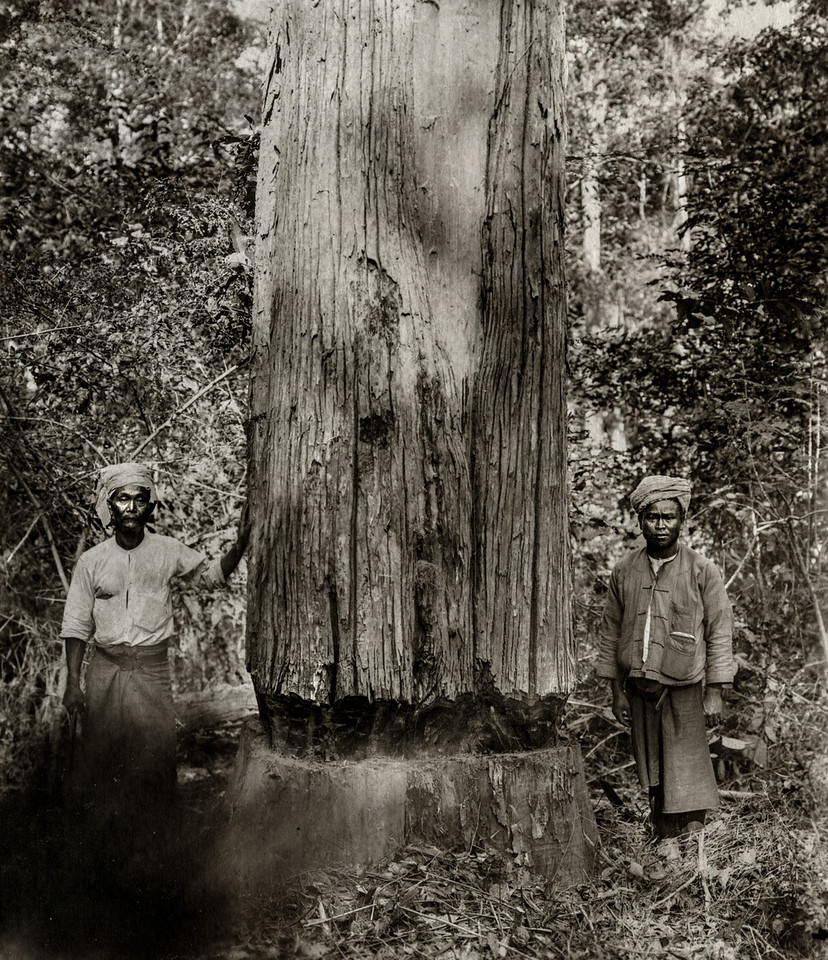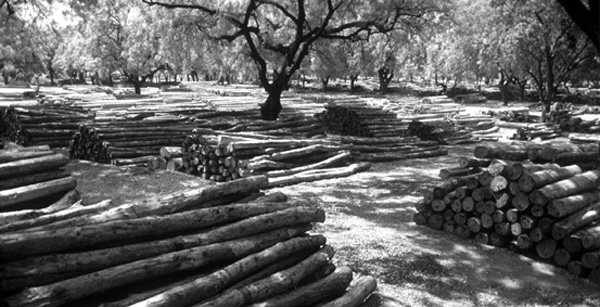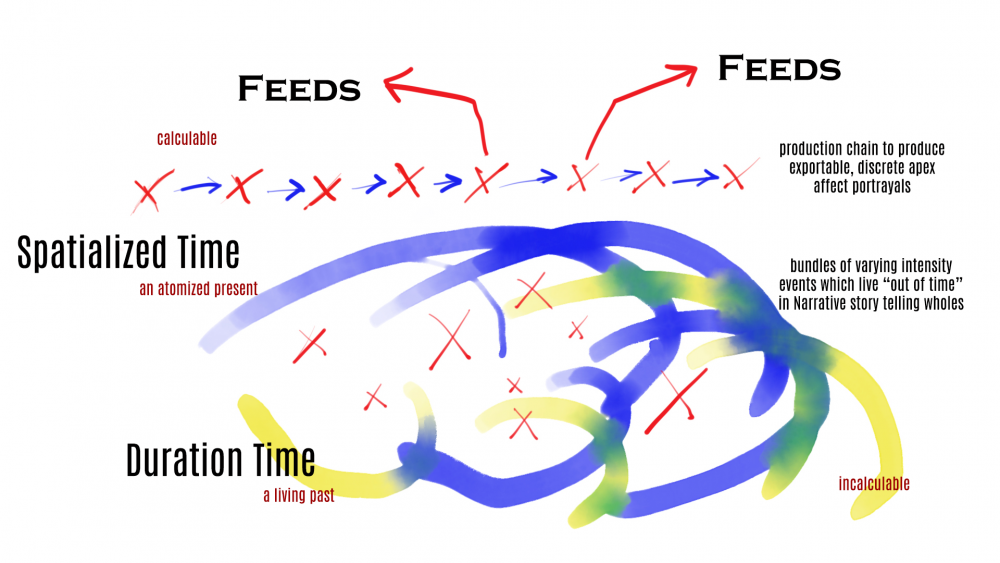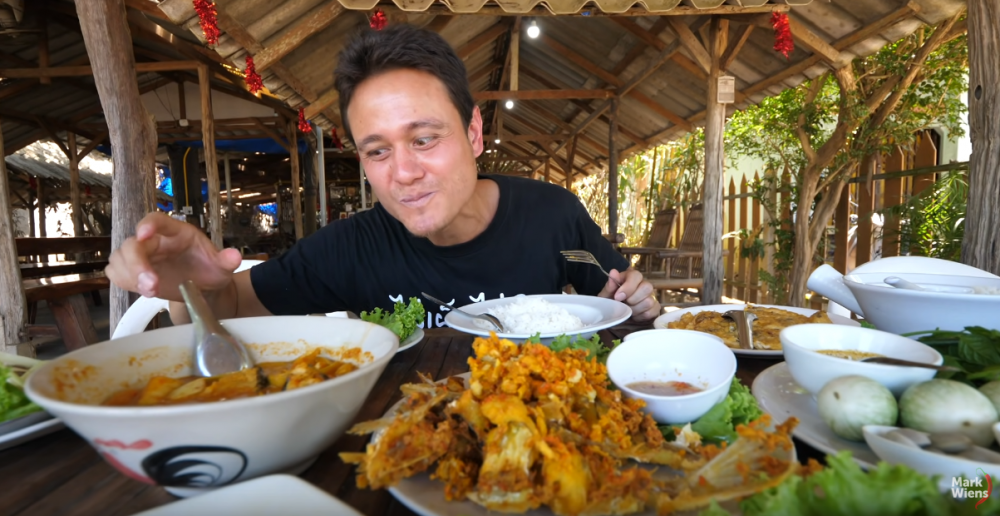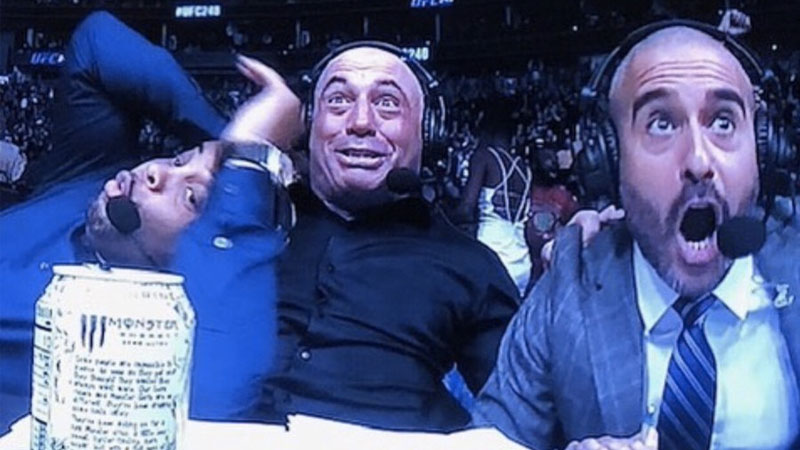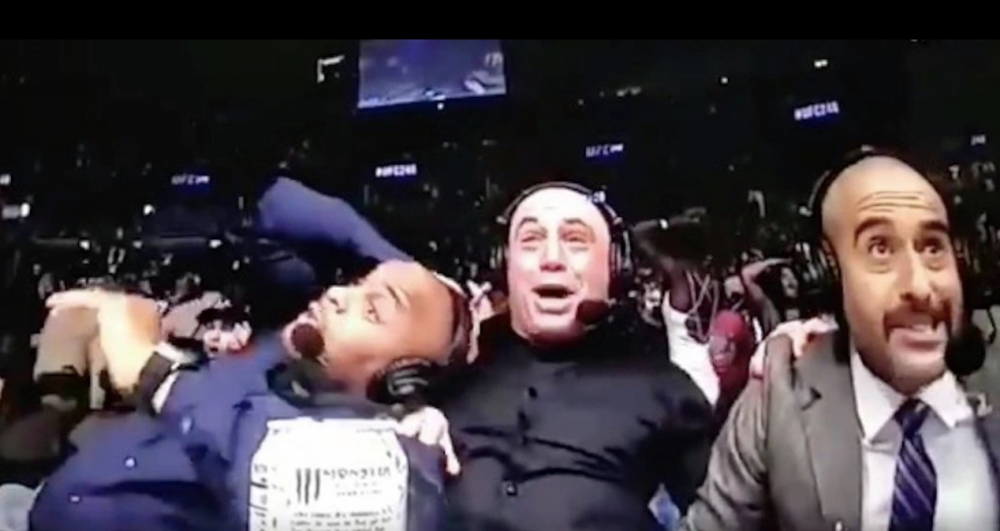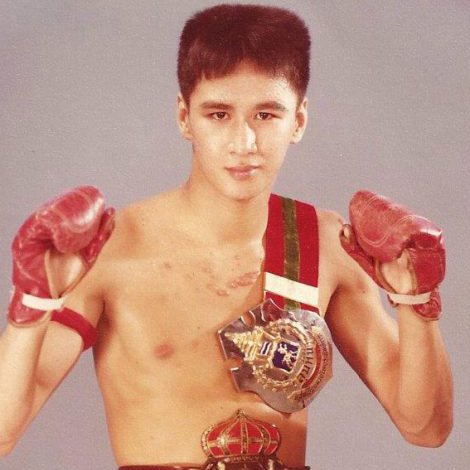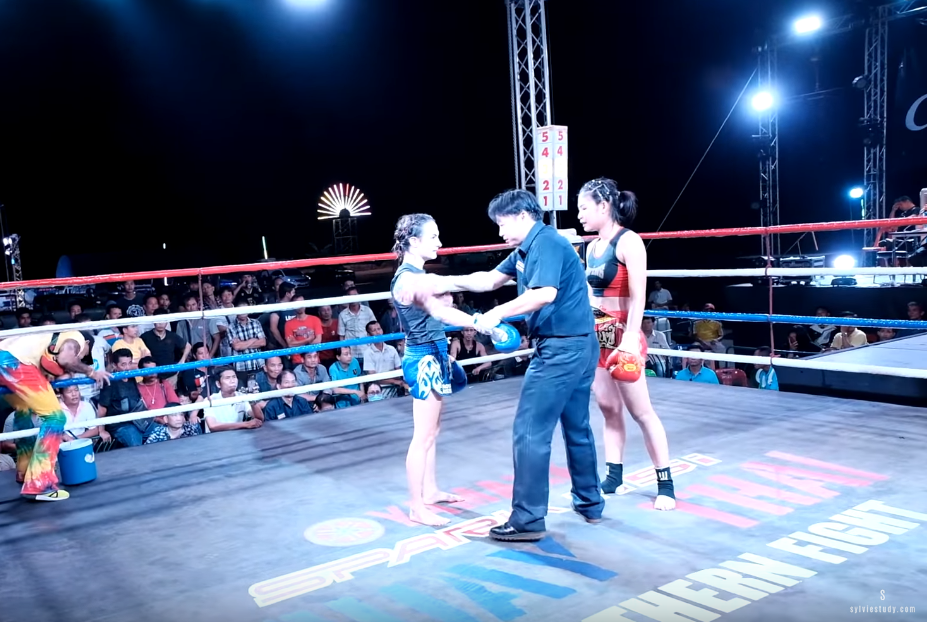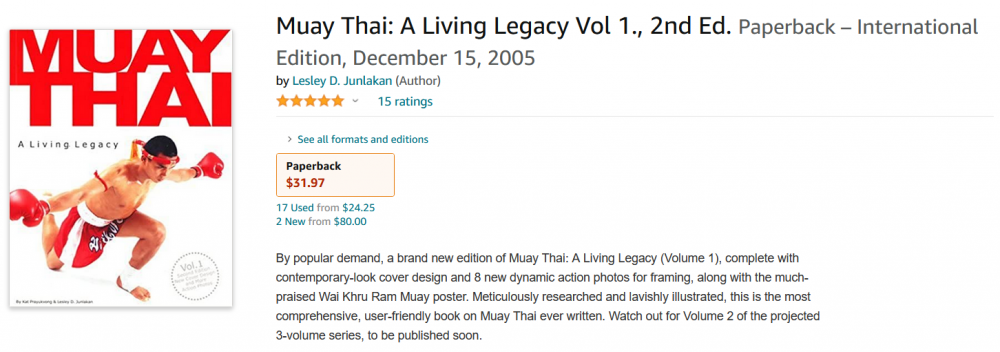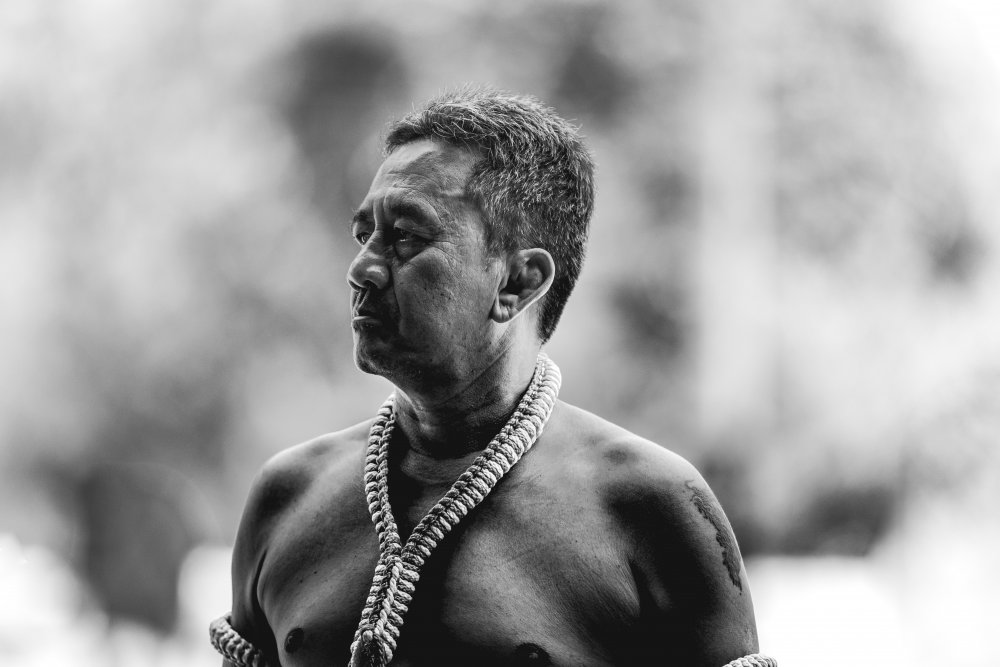-
Posts
2,264 -
Joined
-
Days Won
499
Everything posted by Kevin von Duuglas-Ittu
-
There are two/three important terms in the Philosophy of Deleuze & Guattari. Territorialization, and Deterriorialization (and re-terriotorialization). There is a lot in this Philosophy which is purposively obscurantist, in the way that one might write poetically, to draw in the maximum number of associations and ideas, to develop a kind of intensity in your expression, but at the same time letting that density of idea act as a filter, letting in only readers that only want to dig for, and help create the meaning. There is much debate as to whether this kind of writing is a good thing, or a bad thing. Is clarity of the highest value when expressing ideas? Does clarity trump all other expression? Maybe. But in the pleasures and powers of reading and writing there are other powers. For a moment though I want to simplify these terms. Make them plain. Because they help with what I'm talking about in terms of Narrative powers and meaning-building. Picture this. When something is IN the earth it is grown in, it is territorialized. It is in its territory. In its context. It is within the realm in which it is made. It is earthed. A strong, hardwood bodied teak tree, in the ground in which it developed is earthed. If you want to know what that tree is, you understand it in its territory. It's immense size is composed of a duration, which is to say that its past is presently living in it. It is a temporal whole. And this whole extends well beyond its physical borders or properties, no matter how we would like to isolate them. If the tree is harvested, cut down, it has been de-terriotorialized, in Deleuze & Guattari's terms, it has been unearthed. It has been torn from its contexts, the living whole which produce it...and the living whole which hold what it is...its story. If it is cut and stacked (these are much smaller teak logs), the de-territorialized (un-earthed) teak has been re-terriotorialized. It has been re-earthed. What does this mean? Well, if you were a home builder and you lived around lumber yards, "where teak comes from" wouldn't be a forest at all. It would be a place where it is stacked. This is where the teak (material) would gain new context, and new meaning. We get this all the time with food. "Remember to pick up some chicken!" doesn't mean: "Go catch a chicken!". It means: Go to the chicken-gettin' place, where all chicken is found. The territory of Chicken is wrapped in plastic, cut into body parts, on refrigerated shelf. When things like teak or chicken are re-terriotorialized, re-earthed, their original stories are pretty fundamentally lost, or cut off. Our narrative understandings of them begin with where they come from. They come from the lumber yard, or the poultry shelf. The branch of Philosophy wants to call our attention to these kinds of powerful recontextualizations of things. They argue that a fundamental force of Capitalism, is its power to de- and re- terriorialize things, people, ideas, feelings, to tear them out of their "earths", and to put them into new earths. This can be creative and productive, but it can also be destructive and debilitating. The first step though is to just even be aware that un-earthings are even happening, and that they are happening everywhere. If we lose track of these things we just get presented with a "reality" of the world which we can become trapped in. We literally think that chicken comes from the store. What does this have to do with Muay Thai scoring? Let's put it this way. When you start bending and twisting the sport of Muay Thai, pushing along the lines of spatialized Time just so you can produce KOs, so that these KOs can be harvested, that is deterriotorialized, that is unearthed, and put into the lumber yards of social media feeds, and highlight videos, you have started to farm combat sports. No longer is it This great tree which grew in this rich patch of forest, it is now This spectacular knockout which came out of this fight promotion, or this Instagram account. Why does this matter? Well, in the posts above I discuss how the very powers of rich meaning-building are embedded in the narrative form of Thailand's Muay Thai, and the the vital force of the sport is connected to this. We want as meaning-beings to enforce the powers of narration. And in fighting, narrative performance seems to allow us to process our own tramatic lives and sorrows. This is important stuff. But, on another hand, if you just start farming teak from where it comes, there will be no old-growth teak left to harvest. It takes a long time to grow these trees, and an ecosystem of living things as well. The quality of the wood, yes, you can chop it up and make lots of commercial gain (and even good) from distributing it. But once it is chopped up, it is gone. Now, you suddenly have farmed teak. Teak, which is no longer what teak was. And, as the demand rises, you may not even have even that. You may have "just as good as teak!" woods. The memory of teak begins to fade. The duration of teak begins to end. When we live in a world of knockouts and clashes. Where things get "blowed up!" over and over, we are living very different affective lives. Our storytelling powers, as human beings, becomes diminished (we are just hunting the next stimulation), which means our own ability to weave new futures out of our tramas and sorrows becomes weakened and atrophied. In fact, it comes to be that it is OUR affects that become farmed. This, afterall, is what social media is, the farming of (and maximalization of) our ability to feel and respond. Our affects are passed into feeds for others to consume. Just as fighters come to be pushed into non-narrative clash-fests, looking for sparks, so that their affects can be passed into "highlights", we too become living donors to an entertainment of largely meaningless peaks and jolts of what's human.
-
I'm sure that for many this will only add to the confusion, but if you are confused just read back on what was written before with emphasis on the initial post. My crude but graphic expression of two kinds of Time. Spatialized Time and Duration (Narrative) Time, as it relates to fighting entertainment. Maybe the graphic will give others openings for their own thoughtful speculation and analysis.
-
The Pornification of Enjoyment It is worth talking a little bit more about the Joe Rogan crew "reaction shot", which has become something of a visual trope of the UFC broadcast. To many these are very real and natural reactions, very real excitments which are fundamentally honest - I'm less concerned about the honesty of them, but to many the honesty is closely tied to their enjoyment. I really didn't start to write this thinking about this reaction shot. Instead I wanted to focus on the importance of Narrative in our lives, a change in our perspective on the very nature of what is Meaningful. This is BIG idea stuff. Big Culture. This is the stuff of what we weave our lives. And, my point, was that as we alter the values of our fight entertainment, and the very structure of its asethetics, we might be losing very important dimensions of what it means to be human, or what sport can really give to us, to nourish our lives. The Rogan Crew photo was meant as a stand-in for how media of Sport largely now is about creating little packets of charged excitement, that can then be duplicated ad infinitum, pushed through our Feeds. The pushing of affect, across space and time, is the very force of social media, and why it is a dominant influence on how we see the world. But, the side path of the integrity of the "enjoyment" moment is an interesting thing to think about. There is a REALLY good food reviewer on YouTube. Mark Wiens. He is a full time eater, full of knowledge, discernment and passion for the food of the world. No doubt. But, after binge watching a bunch of his videos we noticed that he would go into a full-on face orgasm when he first took a bite of food. He became internet-famous for this moment in a tasting. He would shovel a WAY too large bite of food, like he was gorging himself on it, and then roll his eyes around like it was this absolutely intense experience. And...he would do this video after video, video after video. To be fair, these are long form videos, but they almost always had these facial moments. I haven't watched him for a long time, well, because once I noticed how predictable this response was, it just kind of took the air out of the bag. It's like when a porn actress suddenly is seen as "acting" her pleasure. It semi-ruins it all...but not entirely. It's still a great show, I won't say that I wouldn't enjoy it if I watched another episode tonight, and I'm not even going to say that Mark Wiens is "acting" like he enjoys food. He likely really enjoys food, even these particular foods, but at some point this very intense response became a "thing", and his "thing" became his hook. I screen-shotted a randomly picked video (below) but you can see it in action here: Now, this "overacting" is what makes him so good at what he does. It invites enjoyment. It leads us into enjoyment. But, it is also part of much larger trends in media consumption. It's about producing the jolt of stimulus. The affect charge that can live and distribute in Feeds. This is where we get to the Rogan Crew reaction trope. It very well might have been an "honest" or "real" reaction...though, there must have been some thought at some point, in placing the reaction camera there in the first place. And even when repeated, and intensified, like Mark Wiens' orgasmic food taste, it still can be very real...but It's about how media has become structured...and I say structured around these bite-sized moments. A very different concept/experience than narrative building, which is to say the creation of meaning itself. Pleasures, down to our very DNA themes, had meaning in the narrative events that surrounded them. You climbed a tree (a narrative), you got stung by bees, you tasted honey. You got chased by something big, you turned on it and fought for your life, you were safe (a narrative). More and more the "sweet" apexes of experience are being cut out of narratives, or narrative building. This is really the pain of drug addiction, of course. You have receptors in the brain built to be stimulated in rich narrative structures of lived life, but, instead, you put a pipe to your lips and blast those reward structures with a jolt. The structures of affects are being ripped from the fabrics of meaning-building. The hidden truth is that these affect blasts aren't being torn from narrative altogether, they are being we rewoven into narratives, but narratives over which we have much less control. The blast from the pipe comes in the narrative of procuring the crack. Suddenly, you can't help go get the crack, and start that story again. The narrative is being written for you. You have lost the ability to tell stories. It's not too far to say that the very same thing is happening with those little dopamine hits on your Facebook feed. You're getting hits, hit after hit, in a story you can't break free from. This is 30,000 ft view stuff. The point about narrative arts is that they return us to the powers of storytelling, and the traditional narrative structure of Thailand's Muay Thai, I suspect, is closely related to some of the oldest forms of human drama and narration. Twisting it into KO-hunting highlight kickboxing, so it can serve affect-peaking feeds, lives that are organized around a kind of pornification of the human [and I should explicitly say, I am NOT against pornography, and I'm not using "porn" as a moral marker...I'm using it a tracer on process], seeking spikes in experience, is a loss. And this is where we come back to the Rogan Crew "reaction shot". I'm not saying its "fake", or at least I'm not saying that its reality isn't the thing of the most importance. It's that the very form of fighting entertainment is structured around these kinds of event-experiences, peak affects separated out from the very form of meaning building.
-
I should say, there have been some interesting and worthy public & private reactions to the piece above. And I'll admit that I left the short article open-ended and epigrammatic with that photo. I wanted it to be openended, the idea that this photo of "joy" could also be a "haunting" photo, and what that might mean. I'll admit, it could lead to mis-understandings, or over-emphasis on that moment. Hopefully it also leads to flights of thought and decypherment too. One of the best responses I got though was from a long time NBA scout who said these concerns very much mirror what happened to the NBA in the 1990s, and the rise of the emphasis on the dunk. This paralleled the coming dominance of ESPN's Sportscenter (for those that lived through that change), and the highlight. The dunk and the highlight went together. The same thing happened to the homerun and the highlight in baseball - with the subsequent juicing of the ball and the player. The way we consumed sports changed, and with that the very sports themselves. In the occasion of basketball, a much less narratively driven sport to begin with, the crescendo of the dunk became paramount to skill. It became everything. And since there have been more evolutions. Now the endless stream of deep 3s, and statistical pictures have arisen. It makes an informative story. But, as I said, basketball wasn't really a narrative sport. In fact it was structured quite numerically - which is not to say that narratives did not ground its enjoyment & celebration. With Thailand's Muay Thai, we are dealing with a much older form of an art, the very art of storytelling embedded in the fabric of the sport. In cases like these the highlight-ification of the sport, the hunting of the KO, the twisting of the rule set and criteria, creates a deeper sense of loss. A loss not only of skill level, but also of meaning, and the rich value we might get out of fighting as something we watch, richly.
-
There is a minor story in Philosophy, emphasized by Henri Bergson, that in the West there has been a vast misunderstanding of Time. We, from a very early time, have Spatialized Time, putting it under the auspices of the Kingdom of Space. We take Time - which is a completely other thing - as a series of discrete moments, one after another. This moment, then that moment, then another. Each one, mysteriously and indefinably begins and ends, like points we can draw on a page with a pencil. Bergson insisted that there was another thing. Duration. Duration is a very different thing. In duration the past is bundled up in the present. It literally lives on, in the present, bundled. And, poets & cinematographers might argue, this is everything that our world is made of. It is an entire cascade and weaving of duration...and durations within durations. This is the foundation of the art of Narration. Narration takes as its cornerstone the idea that the past cannot die, it cannot be made to stop, because everything is bundled. Notes played at the beginning of a song do no cease when their physical vibrations have ended (itself a very difficult thing to identify), but persist, bundled, throughout the score...and then, persist in other scores even. Durations within durations. These thoughts came to me, or tied themselves together, after reading Sylvie's new writing Leaving Pain to Weakness, with some other influences...watching Shadow and Bone (which plays with time layers) and listening to a podcast including Bergson. But mostly from reading her piece. A painful thing, as much as we like it to, cannot end. Just as anything cannot end. All of it is bundled. Even if you end the song, it carries on, it carries its force of notes, up into the other songs...all songs. The only way to change the persistence of a note, a memory, a fact of the world...the ONLY way, is by the notes you play after it. Duration. This is the gift, and the burden of duration. We are all faced with difficulties. We are all faced with weaknesses. With sorrows. With great things that we wish that never were. But, these are living notes. They are part, not only of our duration, but the durations of all the others around us. The only redemption of any note played, is the next note played, and the string of notes we are beginning. And, in our lives, we live musically, playing notes that carry forth the past as a living thing, singing it into greater sweetness, capacity and continuity. So, what cares any of this of Muay Thai scoring? Muay Thai is at something of a crisis. The industrial, globalized forces of the world very much want to make of its scoring structure, and its actual dramatic effort, a spatialization, woven of discrete "points" (damage done), whereas the Art of it, what the Muay Thai of Thailand has been woven out of is a Narrative thing. Events in the first round reflect back onto the 4th round, narratively. A Muay Thai fight is a duration. Fighters in Thailiand fight fights as if they are storytellers, not demolition experts. This is a very old way. Why it matters is largely connected to why fighting matters. Fighting is one of the oldest dramas. It is a duration. The art of fighting teaches us all, celebrates for all of us, the power of the story. It is the very way in which the early sorrow, in all our lives, can and should be redeemed...by the next note played. The great fighters of the world are not those who are not touched. Who are not wounded. They are those who have been wounded, have suffered, but have redeemed themselves. Not by erasing their weakness, as if we can turn the pencil upside down and scrub it away, but embracing its duration, its persistence, and weaving it forward into sweeter notes. This is the very fabric of what we are, and in fact this is really how we read sport, and art, and song, no matter how those forms have been distorted towards Space. What is beautiful and worth preserving about Thailand's Muay Thai traditional scoring is that the aesthetic, itself, embodies this Narrative truth. It is meant to turn weakness, into strength, and to teach us how. Instead, stories all over the world are being chopped up into "events", much like dots on a piece of paper. In fighting these events are "clashes", which become exicised from their living material, and exported into highlights, pushed out into feeds, conveyor belts into emotional mouths. Everything is chopped and loaded. Fights exist to produce more and more clashes. We just want men and women to "spark". The bigger the spark, the further it goes into our dark night, echoing into feeds. This is why the knockout is so vital to combat sport. Human beings are mammalian flint, used to start fires to simply draw others into the entertainment form. The art of Narration does persist in all forms of fighting, because we are Duration Beings. This is how we navigate our lives. But fighting itself becomes less enriching, and much more a digital coal furnace, stoking an engine driving a train on tracks we don't even know or care about. Fighting arts become more stupified. 5 round fights become 3. Defensive soft genius is melded hard into wind-milling animus. Everything is bent towards the discrete event. Winners are made up of whoever greedily piled up the most events, as if chips on a table. And all of it is a vast machine of: This terrible photo, and its endless repetition, as these stooges attempt to re-enact it over and over, fight after fight, haunts me.
-
Here's a graphic of the current WBC rankings, at the time of this writing, and the fighters Sylvie has beaten, and those she's fought, just to give an idea of how far Sylvie has journeyed up in weight. The WBC rankings are at this point approximations of the best Thai fighters in Thailand - there are many good Thai fighters missing from this list - just because the information sources an org can draw on are limited and the Thai female fight scene is fluid, but it does give sense of Sylvie historic reach as a female fighter: WBC rankings - has beaten, has fought.pdf
-
Look at the size difference. Sylvie fighting for her 1st *World Title*. No fighter in history has had to beat top fighters 3 weight classes up to even be credited as "world class". Sylvie is a 95 lb fighter. That's her cut. This was at 108 lbs. Recognized historical western fighters in Thailand, instead have by-and-large feasted on large weight advantages, allowing them much greater freedom in the ring. It is Herculean to have fought at such a high level, so prolifically, giving up HUGE weight as a handicap. In Thailand it's something to quibble about a lb difference. You give a pound to someone who is at a disadvantage. Two pounds. Three pounds...at about three pounds its beyond the scale. It makes an enormous difference to be fighting opponents way out of your weight class, the things you can do, the things that will show effect, its an entirely different world. It's extremely difficult to know what a fighter is facing big weight disadvantages, especially at the lower end of the weight class scale. Five pounds to a 100 lb fighter isn't the same five pounds to a 130 lb fighter, yet Sylvie gives up 5 lbs, 10 lbs, even 15 lbs regularly, facing the best fighters of Thailand (ie, categorically as a class, the best in the world). It's unheard of. Western fighters are given lopsided weight advantages in the country, left and right, advantages that mostly go unseen. What is really unseen is the Light Under a Bushel of Sylvie as a fighter, the Bushel of enormous weight differences. The fight:
-
We have a monthly column, free for everyone, on Sylvie's Patreon, discussing the best fights in Bangkok. At the bottom of every article is a "how to watch BKK fights" suggestion, which may help you. You may need to get a VPN though, I'm not sure. Check it out here: https://www.patreon.com/posts/49816347
-
Well, this is just playing around with the ideas you present. You know you can't turn up the power for obvious reasons, but you can do a lot of things to handicap yourself against smaller fighters. Devote rounds to just teeping (teep the thighs, the waist, the chest), improving your eyes and timing. You can keep the power down and set challenges to yourself like: Only throw in 3s, or if 3s are easy, only throw in 5s (so you can learn to feel the holes in your combination choices). You can eliminate hands, and just work defense and kicks in flow. All these kinds of handicapping will increase your timing and vision which ultimately will give you advantages with opponents at your size. Also, I don't know if you are a patron yet, but there is a new Muay Thai Library session which might really change your game, because you have limited training opportunities. It's an hour session on shadowboxing: https://www.patreon.com/posts/49616909 20 minutes of vigorous, creative shadowboxing can really build your flow and your stamina. Sylvie's one of the best conditioned fighters on the planet, and it wiped her out. It's an approach to shadowboxing that I've never seen before. And, while you are over in the Library there is a really good session by a fellow Big Boy, Kru San: https://www.patreon.com/posts/16912720 It's really inspirational to see how light and smooth he moves, but also the whole session is about ring control, one of the more ignored aspects of Muay Thai basic training. If you can bring ring control to your bigger bodied moves your game can take leaps and bounds of improvement. Hope some of that helps!
-
Answering a Redditor question as to why there are no complete and detailed books on Muay Thai history in English, this was my guesstimate: If you dig into some of the English language academic articles on this page, you can find some solid treatments of aspects of Muay Thai history: https://8limbsus.com/muay-thai-thailand/text-academic-articles-muay-thai-masculinity In general though, take with a grain of salt and a critical mind forms of historical knowledge that are not of a direct lineage, or supported by historical documentation, I would suggest. I'm certainly though, no expert in this, just my take.
-
A conversation over on Reddit lead to me to film the first 40 pages or so from one of the better historical accounts of Muay Thai, from a pretty good book. This stuff isn't easy to come by. You can see it below: You can get the book on Amazon here: https://www.amazon.com/Muay-Thai-Living-Legacy-Vol/dp/9749293703
-
Just dropping this here: I'm kind of mesmerized by this photo. I knew I had it the moment I hit the shutter. I took several more to be sure, but sometimes the subject and the device just connect. You can see a higher res version of the photo here: https://www.muaynoir.com/Prints/i-z63TzJ3/A What I wanted to think about in this post though was the way that black and white, and that old school luminescence can bring an incredible throwback feeling that feels important with older legends of the sport. Muay Thai is, in the end, in Thailand a performance and capture of masculinity. As Muay Thai changes and bows to the pressures of the the west/global aggro fighting, so does the masculinity being portrayed. This photo just seems to throw me back into another time. Pudpadnoi fought his first fight in 1965. He assumes this aura even at the age of 70. The things we can bring about in our edits have huge aesthetic ramifications, because they help us see things in a different way. The men, the sport.
- 1 reply
-
- 2
-

-
These are older links, not all of them will be functioning. It is highly unlikely that there will be another Muay Khao Summit. We can never say never, but it just isn't feasible at this point or the foreseeable future, unfortunately. It was a beautiful, one-time thing.
-
This post cannot be displayed because it is in a password protected forum. Enter Password
-
A very nice, very functional kick, but to my eye if you are chasing the style of the Golden Age, the hip rotation is coming too soon, and maybe too rotated? You want that upward verticality in the beginning that is meant to slip through the opponent's guard, and make the kick a little harder to pick up, then the whip over.
-
I was going to suggest Kru Pot from the Library when I started reading your question. He just has a great energy, seems to take his fighters seriously. If you enjoy the Muay Khao style he teaches it very well, with a large vocabulary. It's a smallish gym which may add to the feeling of more personal attention. As to Thailand and opening up, there is tremendous pressure within the country to open up to tourism, so it's going to happen more quickly than not. One can never guess accurately though, because if the open up and a variant comes in and sweeps through they will slam the doors shut very fast. The country has a kind of schizophrenic relationship with the West. On the one hand it loves and relies on Western tourism, with large parts of its economy tied to it, but it also has very insular elements, which is why it has been so successful in warding off COVID in the first place. So, it really depends on what happens in the first month or so once they open up the doors to the world.
-
We've not heard of career ending injuries, actually. I think a large measure of retirement is that these fighters have been fighting for more than a decade, and there is a kind of sense that it is just work that you'd like to quit. Yes, there is fame at the top of the game. but there is also the sense that fighters are kind of low-class workers, grinding. They do not carry esteem across the culture. I think Thais also have a very quick "old man" setting, when viewing fighters. Fighters, after their peak fame often just start training much less rigorously. They start drinking more, feel that they can get along in fights just based on their IQ. Everything just slows down, not just physically, but also emotionally, I suspect. Chamuakpet though fought a LONG time. I think he fought into his 30s, at a very high stadium championship level, if I recall. You can hear a little bit about the slow down in Sylvie's Interview with Namkabuan (turn on English subtitles):
-
A really important passage authored by Sylvie, in an article on the nature of Muay Thai, Buddhism and Masculinity. Sylvie and I both wrote on this article, but the portion was by Sylvie: You can find the full article, including a link to a chapter of Peter Vail's dissertation here: https://8limbsus.com/blog/thai-masculinity-postioning-nak-muay-between-monkhood-and-nak-leng-peter-vail
-
In adding the above, the topic of the ethics of Child Fighting in Thailand actually brings much more series light onto the pressures from the West (and by Internationalization) to make Thailand's Muay Thai much more aggressive and violent (ie, changing the format, the scoring criteria) to fit in the world wide aggro fighting for commercial viability reasons. What makes Thailand's pedagogy of Muay Thai of value to child fighters, one could substantively argue, is that the principles of traditional Muay Thai are aesthetics of self-restraint. The Muay Thai taught and fought in rural Thailand, and in festival rings around Thailand exactly ISN'T the aggro-Muay Thai that many westerners (and some Thais) are advocating for. Part of the reason why Westerners object to Child Fighting is that fighting in the West is principally seen as a realm of violent emotions. Just the things child should be protected from. As the West pressures Thailand to exhibit more aggressive fighting aesthetics, it is altering the very fabric that makes child fighting have value: the communication and discipline of Buddhistic culture principles. Ironically enough, the West is essentially arguing against itself as it pressures Muay Thai to become more "aggro", but also to exclude Thai children from fighting. It is imposing its own vision of Fighting, and then saying "this is inappropriate for children". What is risked to be lost is that traditional Thai skills and scoring aesthetics have much greater cultural value, both in the National rings, and in festival rings where youth learn to express those forms of masculinity, the cool, jai yen, yen heart, the self control and control over your space, and the priority of defense and composure. Both cultural positions seem to be in agreement. Westerners and Thais believe that children should be protected from "violent emotions". But in traditional Thai fighting aesthetics this is what the art of fighting is. Learning to overcome and insulate oneself against violent emotions, because violent emotions are not what fighting is about.
-
I'm going to manually add some Reddit conversation here that is pretty good: https://www.nytimes.com/2018/12/23/world/asia/thailand-children-muay-thai.html -- This article also says "By many estimates, more than 200,000 children under 15 regularly compete [in Muay Thai]" though it doesn't say where this estimate came from. Like many camp owners, Pramote Sang-a-roon, the owner of Mor Ratanabandit Boxing Camp and a World University muay thai instructor, is far from happy with the idea and insists that boxers were safe if properly trained.“They’ve learnt how to protect themselves and won’t get hurt so easily if they are physically tough,” said Pramote, who has around 50 boxers at his camp in Nong Chok. Poor children would be affected if they were deprived the boxing stage, he said.“How would they put food on the family table? Remember that these children have difficult lives,” added Pramote. Boxers at his camp are guaranteed a high education with at least a BA degree if they are well disciplined. https://www.nationthailand.com/sports/30357284 This one I found especially cool because it tells the story of Pattana Kitiarsa, a researcher who studies Thai culture and masculinity (and who himself is the son of a former nak muay & referee). [p15] Poor country boys were particularly keen on and fond of muai Thai. They gradually learned through the experience of annual temple fairs that their boxing skills could earn some much-needed cash. If they were brave, not easily frightened by opponents, and trained properly, they too could show off their muai Thai skills in the ring in front of their village neighbours. Most boy fighters have their fathers or male relatives as their amateur coaches and corner men. During my childhood in the mid-1970s, young boy fighters were featured in the ‘pre-game show’ bouts and each one could earn Baht30–50 for his three-round efforts. Of course, if one could not stand a fierce knockout, the fight ended prematurely. My father was very knowledgeable about and well connected in the local world of muai Thai. He earned most of his high school payments from boxing. He even went to fight in Bangkok’s prestigious Ratchadamnoen Boxing Stadium a number of times in the early 1960s. He has been a die-hard follower and enthusiast of the sport throughout his life, and has engaged with his favourite pastime through daily and weekly boxing news reports in the local Thai periodicals and live muai Thai shows on TV over the weekend. When he became a village schoolteacher in 1964, he went on to serve his school and local village committees as a boxing referee, competition organizer and promoter. However, he never taught or encouraged me to pursue a career in muai Thai. He simply said that it was too harmful and dangerous a sport. One could easily become paralysed or disabled from this physical game. It was reserved for those boys from poor families who had real talent and genuine fighting spirit. It is part of some painful reality in the imbalanced socioeconomic development of Thailand that the poor countryside has supplied unskilled and cheap workforces to the urban and industrial sector. This is also true in the Thai boxing industry, where most, if not all, muai Thai boxers come from poor rural or working-class backgrounds ‘Lives of Hunting Dogs’ Muai Thai and the Politics of Thai Masculinities by Pattana Kitiarsa And since we are on the topic about kids fighting, here is another section in the same article. It's the opinion of Choi Phuangthong, a veteran muai Thai camp owner/manager and trainer in Khorat. A twelve-year-old boy is at his best time to begin his muai Thai training. At this age, the boy is obedient. He listens to and remembers by heart whatever we instruct him. If I had to start over my muai Thai camp again, I would not want to train a boy from a well-to-do family background. I want boys from very poor families. I believe poor boys take boxing more seriously than well-to-do boys. They are more perseverant and able to endure hardship and suffering. They see their parents’ difficulties before their eyes, so they will use their parents’ real life lessons as incentives to train themselves harder and make every fight a fight for their lives. I myself did not operate my boxing camp as a business unit. I do really care about all the boys under my supervision. I remembered a poor boy boxer from Buriram. He was exceptionally good. When I ordered him to go jogging or forced him into extra sessions of hard training drills, he obeyed without a second thought. He was twelve–thirteen years old then. When you have many kids under your roof, they will compete against each other to the death in order to be successful. my responses were as follows:
-
What likely sets these "greatest" apart perhaps is the era in which they arose. Their creations in sport and art expressed something at a time in transition, of social upheaval and burgeoning. Be it race, or politics, or commercial art, these "1sts" told a new story at a time when a new story was needed. And Bangkok Muay Thai just at the time of Samart was in exactly this position. Thailand found itself bursting with economic growth. Rural workers flocked to Bangkok, the city flourished with investment. Thailand itself was under an evolution, and the Muay Thai of the Golden Age which he helped usher forward, into the 1990s (the Asian Financial crisis in 1997), was a new art-form, built on the bedrock of the Tough, Hard men of Cowboy Time, flourishing with the femeu legends of that era.
Footer title
This content can be configured within your theme settings in your ACP. You can add any HTML including images, paragraphs and lists.
Footer title
This content can be configured within your theme settings in your ACP. You can add any HTML including images, paragraphs and lists.
Footer title
This content can be configured within your theme settings in your ACP. You can add any HTML including images, paragraphs and lists.

